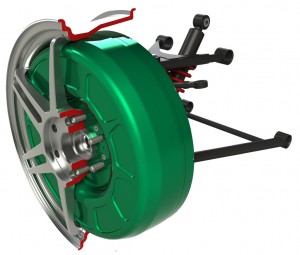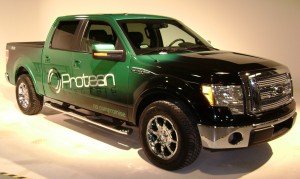The power used to drive any vehicle eventually finds its way to the wheels, so maybe it makes sense to put the motors there.
That’s the thinking of Protean Electric, a new company that has developed electric motors that are installed in a vehicle’s wheels.
The U.S. arm of United Kingdom-based company has developed a Ford F-150 that uses the technology. For the F-150, Protean removed the truck’s V-8 motor and installed bright green Protean Drive electric motors inside the wheels where the brakes normally reside.

Protean Electric can size its motors to fit inside wheels from 14 to 20 inches and can vary the width to meet performance characteristics specified by the manufacturer.
Tom Prucha, Protean’s principal applications engineer in the U.S., said the idea is to reduce operating losses by eliminating drivetrain components.
“Every geartrain that you drive power through causes you to lose power,” Prucha said. “It’s quieter and more efficient to put the power out at the wheels.”
Protean can scale the motors to fit wheels of 14 to 20 inches in diameter. By varying the motor width, Protean can tailor the performance profile to the specifications of the automaker.
But why show the technology on a massive pickup truck?
Prucha said the F-150 is sort of the worst-case scenario for an electric vehicle. Demonstrating the technology on a full-size truck shows the technology will work on just about any type of vehicle. While many people ask him about the vehicle’s range, that is really an issue of battery capacity. While Protean did build the battery for the F-150 project, their expertise is the motors.
The F-150 is fitted with four motors capable of developing a peak of 84 killowatt/hours at 1,200 rpm and 45 kw/h continuously. Prucha did not want to discuss performance capabilities of the truck because the battery in the truck is not capable of providing as much power as the motors can use.
“The motor’s no longer the limiting factor on how much power you can deliver,” he said.
For the F-150, the regular friction brakes were moved inboard, but Prucha said the company is working on plan to integrate the brakes with the motor itself. Regardless where the brakes are located, manufacturers would be able to use smaller ones because the in-wheel design provides better regenerative braking than a typical centralized electric motor system.
The motors can be added to the nondrive wheels of an existing vehicle to create a hybrid or they can be used to create a full electric vehicle. Add motors at each corner to create a four-wheel drive vehicle.
Prucha said the company is equipped to produce about 5,000 motors annually. The company has about 85 employees in the U.K., and several more at locations in the U.S. and Germany. It is currently working with automakers who might build the motors under license and tier one suppliers who could integrate the motors into their own axle assembly to supply to makers.
In the F-150, removing the motor leaves a giant hole under the hood. But Prucha said removing the engine and all of the associated powertrain hardware would allow auto designers new freedom.
“The space that was allocated for the drivetrain, that just goes away,” Prucha said.
Protean worked with EDAG, a German automotive engineering firm on a prototype that makes the best use of Protean’s motors. Called Light Car – Open Source, The front of the stubby people mover eliminates the space normally reserved for engine and transmission. The concept illustrates what could be done if there were no traditional drivetrain to plan around. EDAG says the concept has as much cabin space as an S-Class Mercedes with exterior dimensions similar to a Volkswagen Golf.
While Protean’s system increases unsprung weight – weight carried by the wheels themselves – it also lowers the vehicle’s center of gravity, which designers could use to make the vehicle less tippy.
Prucha said Protean’s technology is reliable because it uses eight submotors. If one goes out, the other seven can still power that wheel.
He added that electronic controls could eliminate the need for traditional traction control and stability control, although anti-lock brakes would still be necesary.
The idea of placing the motors inside the wheels has been around for several years. General Motors experimented with in-wheel motors for its EV1 electric vehicle, but eventually decided on a centralizedpower source. Other manufacturers that have worked on in-wheel motors include BMW and Honda, which originally wanted in-wheel motors for its FCX hydrogen-fuel cell vehicle.
Siemens VDO is working on an in-wheel system called e-Corner and a company called e-Traction has installed it’s system, called The Wheel SM 500/1, on some Dutch buses.
Many who have tried in-wheel motors have run into trouble with the electric cables that feed them. Prucha said Protean’s solution is a supplier’s high-filament-content wire that he said promises the same durability of brake lines carrying fluid to conventional hydraulic brakes.

